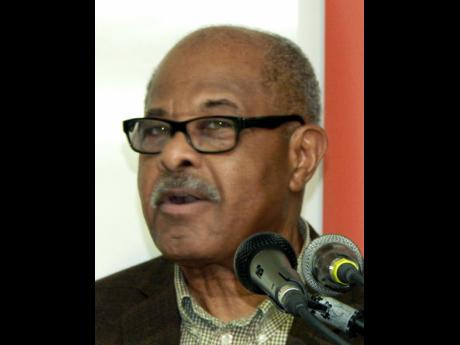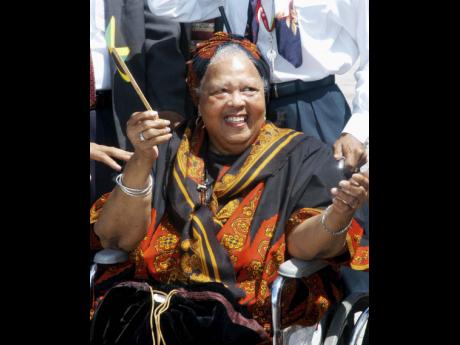J'can music resonates in Guyana
Throughout the last century, Guyana has embraced Jamaican music. Dancehall and its derivatives are the most popular type of music in the South American country.
That information came from the lecture, Jamaica Inna Guyana: The Jamaican Presence in Guyanese Musical Life During the 20th Century, delivered at the Caribbean Institute of Media and Communication (CARIMAC), University of the West Indies (UWI), Mona, last Friday.
It was given by visiting Guyanese lecturer, Professor Vibert Cambridge, professor emeritus, School of Media Arts and Studies, Scripps College of Communication, Ohio University.
The lecture was part of CARIMAC's Distinguished Lecture series, celebrating the institute's 40th anniversary.
Introducing the guest speaker, former CARIMAC director, Dr Canute James, said, "Prof Cambridge's research and scholarship have focused on communication for social change, immigration, diversity and broadcasting, and Guyanese social and cultural history. His doctoral dissertation examined radio serials in Jamaica between 1958 and 1988."
The last sentence caused a ripple of comment among the older folk in the audience. From various corners of the room, I heard the names of some popular radio serials of the time, including 'Portia Faces Life', 'Dr Paul' and 'Second Spring'.
Dr James added that Cambridge's book, Immigration, Diversity and Broadcasting in the United States Between 1990 and 2000, published in 2005 by the Ohio University Press, draws attention to innovations among Caribbean broadcasters in North America. This includes radio link-ups between the continent and the Caribbean. Another of the professor's books, Musical Life in Guyana: History and Politics of Control, will be published next year by the University Press of Mississippi.
Cambridge said, in February 1970, there were eight
Jamaican singles on the Guyanese top 10 music chart (a radio chart based on audience requests), six of them by Ken Lazarus. The others were by Roy Shirley and Boris Gardiner.
By then, Guyana had become a major destination for Jamaican performers and The Gleaner often carried stories about their tours. That moment in 1970, called "the Jamaican invasion", is recognised as a high point of the Jamaican presence in Guyana's musical life.
Ken Lazarus was so popular in Guyana that, at one time in the early 1970s, he was reportedly selling more records there than Tom Jones and Engelbert Humperdinck combined. And, Cambridge reminded his amused audience, "those two were big stuff!"
He said that the "dynamic" musical relationship between Jamaica and Guyana, which continues till today, could be traced back as far as 1901. Calling his research into the relationship "a work in progress", Cambridge explained that Jamaican music in Guyana encompasses multiple genres and social, political and technological forces. The study, therefore, requires a complex interdisciplinary framework.
Cambridge told his audience that not only popular music was involved. For example, in the 1920s, a Jamaican, Hector Josephs, who was Guyana's attorney-general, set up Guyana's philharmonic orchestra. Later, folk music researcher and musician, the late Dr Olive Lewin, did research in that genre in Guyana.
The speaker also took into account the fact that national governance, "the way in which societies make and implement decisions", exerts "a significant influence on what is recognised and approved as music - how it is distributed and how it is consumed." He added: "In Guyana, national governance is influenced greatly by the ruling class and its allies."
Those truths apparently led to him studying Jamaican music in Guyana over four politically significant time periods. The first is the matured colonial period (1903-1953), the first set of elections in Guyana under universal adult suffrage being in 1953. The second is the preparation for Independence (1953-66), followed by the early post-independence era, (1966-1992), which was dominated by Forbes Burnham and the People's National Congress (PNC). The fourth period is from 1992 to the present.
Jamaica's influence has been evident in all those periods, Cambridge said.
Adding to the complexity of the study is Cambridge's classification of Guyana's music into Rural, Urban, Hinterland and Multi-ethnic. With regard to the last, Cambridge said Jamaica's Rastafarians have a Guyanese equivalent in the Jordanites.
The growth of technology is one of the many factors contributing to the spread of Jamaican music in Guyana. The gradual replacement of the piano by the record player in middle-class homes meant more records from Jamaica could be played.
And over the period, radio services took on a pan-Caribbean orientation, Rediffusion International was involved with RJR (as it's now called), Rediffusion Barbados, Radio Trinidad and Radio Demerara. Jamaica was the "star" in the Caribbean radio network, Cambridge said, further facilitating the spread of the country's music.
That spread was assisted when Rediffusion International agreed to support indigenous music and provided recording studios in the territories. One person setting up a studio in the late 1950s was Edward Seaga, whose West Indies Recording Studio was later sold to George Benson, a Guyanese. Later, it was sold to Jamaican music legend Byron Lee, who renamed it Dynamic Records.
The establishment of the University College of the West Indies (UCWI) also helped unite the Caribbean. Guyanese students of the college (and eventually the university) who returned from Jamaica took back Jamaican music.
Lewin not only conducted research into Guyanese music, Cambridge said. She was also a consultant to the National History and Arts Council. Today, as the Ministry of Culture, it has a folk-music section.
The audience heard, with some consternation, that the popular folk songs 'Sly Mongoose' and 'Mi Cawfee, Mi Cawfee', which many regard as Jamaican, are in fact Guyanese. The latter was written by Peter Moses in Guyana in 1901.
Carifesta 1972, held in Georgetown, Guyana, also helped spread Jamaican music, said Dr Cambridge. Its Jamaican line-up included Toots and the Maytals, Miss Lou, the National Dance Theatre Company (NDTC) and Count Ossie and the Mystic Revelation of Rastafari.
In Guyana, by the 1970s, there was growing discontent with the ruling PNC and "Rasta became the voice of resistance." For example, Cambridge said, Bob Marley's 'Crazy Baldheads', with the line "we gonna chase those crazy baldheads out of town", was interpreted by some as referring to the heads Government.
Perry Henzell's reggae-infused movie 'The Harder They Come' was an important vehicle for injecting the music into Guyana, Cambridge said. He took a moment to recognise the movie's cameraman and director of photography, Franklyn 'Chappie' St Juste, who was in the audience.
Another audience member who was acknowledged was popular Jamaican guitarist Seretse Small, son of Guyanese educator and actress Dr Jean Small (also present). Seretse, Cambridge said, was one of many examples of "Guyana music inna Jamaica."









